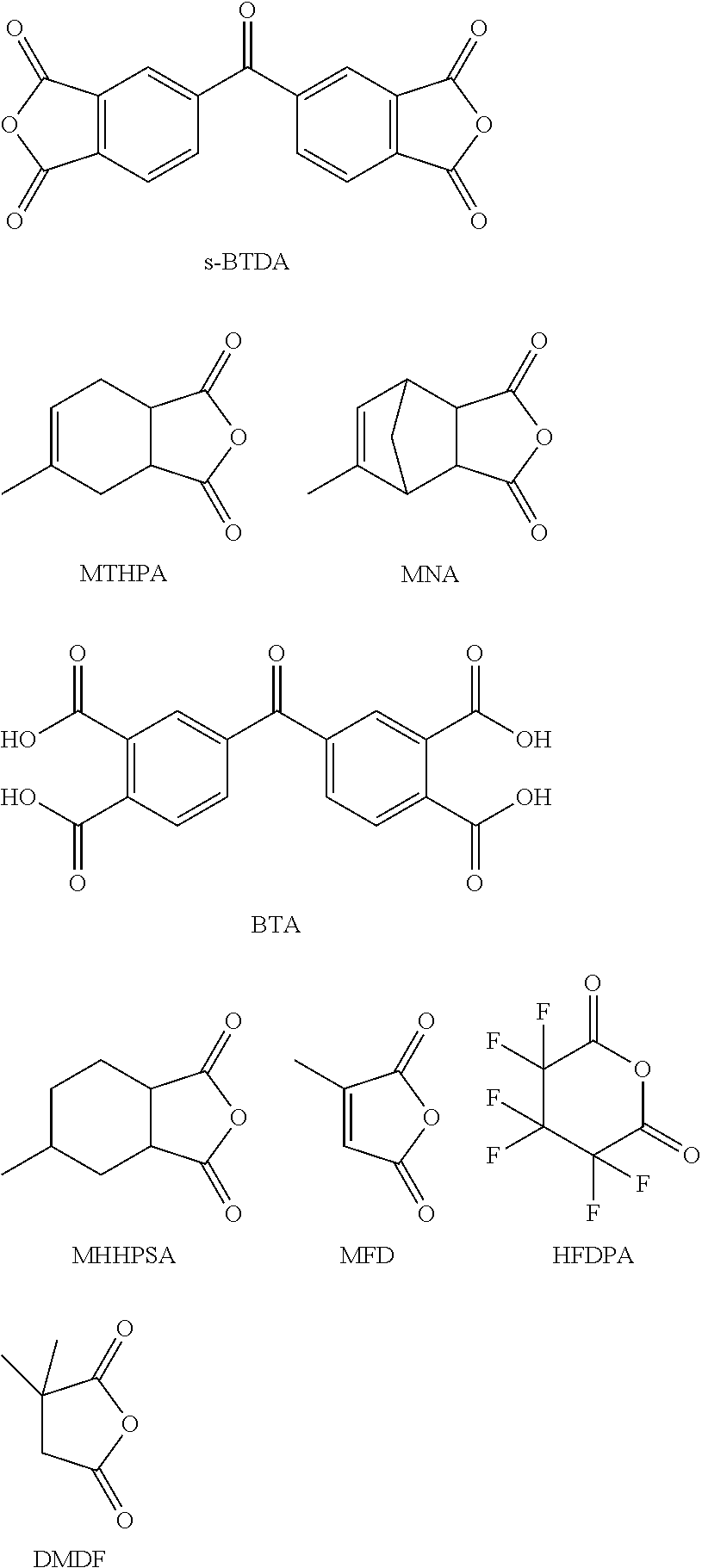Processing-friendly dianhydride hardener for epoxy resin systems based on 5,5'-carbonylbis(isobenzofuran-1,3-dione)
a technology of dianhydride hardener and epoxy resin, which is applied in the field of composition, can solve the problems of low thermal resistance and chemical resistance of the resultant product, skin damage extension, and high volatility of liquid amines
- Summary
- Abstract
- Description
- Claims
- Application Information
AI Technical Summary
Benefits of technology
Problems solved by technology
Method used
Image
Examples
examples 1-10
1. Examples 1-10
Determination of the Gel Time at 170° C. to DIN EN 16 945, Sheet 1
[0117]In a 100 ml beaker, at room temperature, s-BTDA, BTA and MTHPA (Comparative Example 1 and Inventive Examples 2-5) or MNA (Comparative Example 6 and Inventive Examples 7-10) were mixed with one another according to the values specified in Table 1. Subsequently, a wooden spatula was used to incorporate 10 g of the cycloaliphatic epoxy resin CY179 having the following structural formula:
[0118]so as to form a homogeneous composition.
[0119]10 g of the mixture thus obtained were transferred into a test tube, then the gel time at 170° C. was determined to DIN EN 16945, Sheet 1. Table 1 shows the respective gel times obtained. The left-hand column indicates the number of the particular example.
TABLE 1Proportionin theGel timeMTHPAMNAs-BTDABTAhardenerat 170° C.[g][g][g][g][%][min]110.0010.00.00.036.85210.009.50.52.616.00310.009.01.05.312.08410.008.02.011.114.08510.007.03.017.612.916010.010.00.00.060.927010...
examples 11-32
2. Examples 11-32
(Inventive) Formulation
[0121]A 100 ml beaker was initially charged with 9.7 g of s-BTDA and 0.3 g of BTA. Thereafter, MTHPA or MNA was added stepwise in accordance with the amounts shown in Table 2 and the mixture was stirred at 23° C. for about one minute to give a homogeneous composition. Thereafter, the consistency was checked visually. Table 2 below indicates, in the penultimate column, the consistency of the mixture obtained in the case that the monoanhydride compound used was MTHPA (“MTHPA” column) and, in the last column, the consistency in the case that the monoanhydride compound used was MNA (“MNA” column). “Free-flowing” means that no paste was obtained; instead, the mixture was in pulverulent form. “Pasty” means that the homogeneous mixture was of spreadable consistency and remained homogeneous even over a long period, i.e. more than one hour, without the suspended solids content consisting of BTA and s-BTDA settling out. “Unstable” means that the mixture...
PUM
| Property | Measurement | Unit |
|---|---|---|
| temperature | aaaaa | aaaaa |
| temperatures | aaaaa | aaaaa |
| melting temperature | aaaaa | aaaaa |
Abstract
Description
Claims
Application Information
 Login to View More
Login to View More - R&D
- Intellectual Property
- Life Sciences
- Materials
- Tech Scout
- Unparalleled Data Quality
- Higher Quality Content
- 60% Fewer Hallucinations
Browse by: Latest US Patents, China's latest patents, Technical Efficacy Thesaurus, Application Domain, Technology Topic, Popular Technical Reports.
© 2025 PatSnap. All rights reserved.Legal|Privacy policy|Modern Slavery Act Transparency Statement|Sitemap|About US| Contact US: help@patsnap.com


